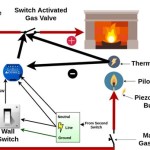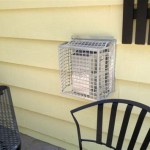Regency Gas Fireplace Insert Troubleshooting: A Comprehensive Guide
Regency gas fireplace inserts offer an efficient and aesthetically pleasing way to heat a home. However, like all mechanical systems, they can occasionally experience problems. This article provides a comprehensive guide to troubleshooting common issues encountered with Regency gas fireplace inserts, offering potential solutions and emphasizing the importance of professional assistance when necessary.
Before attempting any troubleshooting, it is crucial to prioritize safety. Ensure the gas supply is shut off before performing any maintenance or repairs. Consult the owner's manual for specific instructions related to the model in question, as features and components can vary. If uncomfortable performing any task, a qualified gas appliance technician should be consulted.
Pilot Light Issues: Ignition and Flame Instability
A common issue involves the pilot light. The pilot light is a small, continuous flame that ignites the main burner. Problems can manifest as difficulty igniting the pilot, the pilot failing to stay lit, or an unstable, weak pilot flame.
Difficulty Igniting the Pilot:
Several factors can prevent the pilot light from igniting. First, verify that the gas supply is turned on and that there is no obstruction in the gas line leading to the fireplace. A common culprit is air trapped in the gas line, especially after initial installation or after the gas supply has been shut off. Repeatedly purging the gas line by attempting to light the pilot may resolve this issue. Additionally, check the igniter. Most Regency inserts use a piezoelectric igniter, which creates a spark. If the igniter is not producing a visible spark, the igniter may be faulty and require replacement. The igniter wire may also be disconnected or damaged. Ensure the wire is properly connected and free from damage. Finally, the pilot orifice could be blocked. This small opening meters the gas flow to the pilot. A clogged orifice can prevent sufficient gas from reaching the pilot, making ignition difficult. Refer to the owner’s manual for instructions on how to access and clean the pilot orifice. Compressed air can be used to dislodge any debris.Pilot Light Fails to Stay Lit:
If the pilot light ignites but fails to remain lit, a likely cause is a malfunctioning thermocouple or thermopile. The thermocouple is a safety device that senses the presence of the pilot flame. When the pilot flame heats the thermocouple, it generates a small electrical current that keeps the gas valve open, allowing gas to flow to the pilot. If the thermocouple is faulty, it will not generate sufficient current, and the gas valve will close, extinguishing the pilot. The thermopile works similarly but generates more electricity to operate the main burner valve. A multimeter can be used to test the output voltage of the thermocouple or thermopile. The owner's manual will specify the minimum voltage required for proper operation. If the voltage is below the specified value, the thermocouple or thermopile needs to be replaced. Another potential cause is a dirty or improperly positioned pilot flame. The pilot flame should be engulfing the thermocouple tip. If the flame is too small or directed away from the thermocouple, it may not generate enough heat to keep the valve open. Adjust the pilot flame or clean the pilot assembly to ensure proper flame impingement on the thermocouple. Drafts can also extinguish the pilot flame. Check for drafts near the fireplace and ensure proper ventilation.Unstable or Weak Pilot Flame:
An unstable or weak pilot flame can be indicative of several problems. Low gas pressure is a primary suspect. If other gas appliances in the home are also exhibiting low flame issues, the problem may be with the main gas supply. Contacting the gas company is necessary to investigate and resolve this issue. A partially blocked pilot orifice can also result in a small, weak flame. Carefully clean the orifice as described earlier. Additionally, check for corrosion or damage to the pilot assembly itself. Corrosion can restrict gas flow and lead to an irregular flame. Replacing the pilot assembly may be necessary in such cases. A weak or defective regulator is also a possibility, impacting the gas supply specifically to the pilot light assembly.Main Burner Issues: Ignition Failure, Uneven Flames, and Sooting
Problems with the main burner can range from the burner failing to ignite to producing an uneven flame or excessive soot.
Main Burner Ignition Failure:
If the pilot light is lit but the main burner fails to ignite, the problem may lie with the main gas valve, igniter, or the gas pressure. The main gas valve controls the flow of gas to the main burner. If the valve is defective or not receiving the correct signal from the thermostat or control module, it will not open, preventing gas from reaching the burner. Verify the thermostat is set to a temperature higher than the current room temperature and that the thermostat is functioning correctly. If the fireplace has a remote control, ensure the batteries are fresh and the remote is properly paired with the receiver. For models equipped with electronic ignition, a faulty igniter can prevent the main burner from igniting. Inspect the igniter for damage and test its spark output. If the igniter is not producing a strong spark, it needs to be replaced. Low gas pressure can also prevent the main burner from igniting, even if the pilot light is functioning. Check the gas pressure using a manometer and compare it to the specifications in the owner's manual. Finally, if the burner ports are clogged with debris, gas flow may be restricted, preventing ignition. Clean the burner ports using a wire brush or compressed air.Uneven or Yellow Flames:
An uneven or yellow flame indicates incomplete combustion, which can lead to the production of carbon monoxide. This is a serious safety hazard. The most common cause of uneven or yellow flames is insufficient air supply. Gas fireplaces require adequate air to mix with the gas for complete combustion. Check the air inlets around the fireplace for obstructions, such as dust, debris, or lint. Clean the air inlets and ensure they are free from any blockage. Improper venting can also contribute to uneven flames. The vent system must be properly sized and installed to allow for proper exhaust of combustion gases. Inspect the vent system for any obstructions or damage. If the vent is blocked or damaged, it needs to be repaired or replaced. Additionally, contamination of the gas supply can cause yellow flames. If other gas appliances in the home are also exhibiting yellow flames, the gas supply may be contaminated. Contact the gas company to investigate this possibility. Burner ports that are partially blocked can also cause an uneven flame. Clean the burner ports as previously described. Soot accumulation can contribute to flame distortion.Sooting:
Sooting, the deposit of black carbon particles, is another sign of incomplete combustion and a potential safety hazard. The causes of sooting are similar to those of uneven or yellow flames: insufficient air supply, improper venting, and contaminated gas. Check and clean the air inlets, inspect the vent system, and contact the gas company to rule out gas contamination. Another possible cause is improper gas pressure. If the gas pressure is too high, it can result in incomplete combustion and sooting. Check the gas pressure with a manometer and adjust it to the specifications in the owner's manual. Also, ensure the correct burner type is installed. Using an incorrect burner for the specific gas type (natural gas or propane) can result in incomplete combustion and sooting. The logs in the fireplace must also be positioned correctly. Improperly positioned logs can disrupt the airflow and lead to incomplete combustion. Refer to the owner's manual for the correct log placement.Odor Issues: Gas Leaks and Other Smells
Unusual odors emanating from the fireplace insert require immediate attention, as they could indicate a serious problem.
Gas Odor:
The smell of gas is a clear indication of a gas leak. If a gas odor is detected, immediately shut off the gas supply to the fireplace and ventilate the area by opening windows and doors. Do not use any electrical switches or devices, as they could create a spark and ignite the gas. Evacuate the premises and contact the gas company or a qualified gas appliance technician immediately. Do not attempt to locate the leak yourself. A professional equipped with the proper tools and expertise is needed to safely identify and repair the leak. Common leak locations include gas line connections, the gas valve, and the burner assembly.Burning Smell:
A burning smell, especially during the initial operation of a new fireplace insert, is often due to the burning off of manufacturing oils and residues. This is normal and should dissipate after a few hours of operation. However, if the burning smell persists, it could indicate other problems. Check for obstructions near the fireplace, such as curtains, furniture, or debris, that may be overheating. Ensure that the fireplace is properly ventilated to prevent the buildup of heat. A burning smell can also be caused by dust or lint accumulating on the hot surfaces of the fireplace. Clean the fireplace regularly to remove any dust or debris. Over time, improperly positioned logs can result in a burning smell caused by overheating nearby components.Other Unusual Odors:
Other unusual odors, such as a musty or mildew smell, could indicate moisture problems near the fireplace. Check for leaks around the fireplace and ensure that the area is properly ventilated. Standing water and subsequent mold growth may require professional remediation.Other Common Problems and Solutions
Besides the issues already mentioned, some other common problems can occur with Regency gas fireplace inserts.
Excessive Condensation:
Condensation can form on the glass of the fireplace insert, especially during cold weather. This is often due to high humidity levels in the home or insufficient airflow around the fireplace. Ensure proper ventilation in the room and consider using a dehumidifier to reduce humidity levels. Verify that the vent system is properly installed and functioning correctly, as inadequate venting can contribute to condensation. Cleaning the glass regularly can help reduce the appearance of condensation.Noisy Operation:
Unusual noises, such as clicking, popping, or hissing sounds, can indicate various problems. Clicking sounds may be related to the igniter attempting to light the pilot or main burner. Popping sounds can be caused by the expansion and contraction of metal components due to temperature changes. Hissing sounds can indicate a gas leak or a problem with the gas valve. Investigate the source of the noise and take appropriate action.Thermostat Issues:
Thermostats control the temperature of the fireplace. If the fireplace is not maintaining the desired temperature, the thermostat may be faulty. Verify the thermostat settings and replace the batteries if necessary. Clean the thermostat contacts to ensure proper electrical connection. If the thermostat is still not functioning correctly, it may need to be replaced.Troubleshooting a Regency gas fireplace insert requires a systematic approach. Starting with the most common problems and working through potential solutions is key. Always prioritize safety and consult the owner's manual. When in doubt, a qualified gas appliance technician should be contacted to diagnose and repair the issue.

Regency Gas Fireplace Error Codes

Why Your Gas Fireplace Won T Light And Potential Solutions
/U38-U39-B-1920x680-(1).aspx?strip=all)
5 Easy Gas Fireplace Maintenance Tasks Regency

U31 Medium Radiant Gas Fireplace Insert Regency

Reasons Your Gas Fireplace Isn T Working Experts

U31 Medium Radiant Gas Fireplace Insert Regency

Regency Energy E18e Gas Insert Kirkland Heating Cooling

How To Buy A Gas Fireplace Insert Buyer S Guide From Regency

Authorized Regency Gas Fireplaces Dealer In Toronto The Gta

Regency Grandview G800ec Gas Fireplace Electronic Ignition Chadwicks S
Related Posts








